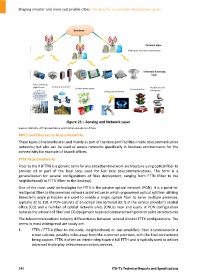Page 250 - Shaping smarter and more sustainable cities - Striving for sustainable development goals
P. 250
Figure 25 – Sensing and Network Layer
Source: Ministry of Transportation and Communications of Peru
MPLS and Ethernet as Access Networks
These types of networks are used mainly as part of the transport facilities inside telecommunication
networks; but also can be used as access networks specifically in business environments for the
connectivity for example of branch offices.
FTTX Access Networks
Fiber to the X (FTTX) is a generic term for any broadband network architecture using optical fiber to
provide all or part of the local loop used for last mile telecommunications. The term is a
generalization for several configurations of fiber deployment, ranging from FTTN (fiber to the
neighborhood) to FTTD (fiber to the desktop).
One of the most used technologies for FTTX is the passive optical network (PON). It is a point‐to‐
multipoint fiber to the premises network architecture in which unpowered optical splitters utilizing
Brewster's angle principles are used to enable a single optical fiber to serve multiple premises,
typically 32 to 128. A PON consists of an optical line terminal (OLT) at the service provider's central
office (CO) and a number of optical network units (ONUs) near end users. A PON configuration
reduces the amount of fiber and CO equipment required compared with point to point architectures.
The telecommunications industry differentiates between several distinct FTTX configurations. The
terms in most widespread use today are:
1. FTTN / FTTLA (fiber‐to‐the‐node, ‐neighborhood, or ‐last‐amplifier): fiber is terminated in a
street cabinet, possibly miles away from the customer premises, with the final connections
being copper. FTTN is often an interim step toward full FTTH and is typically used to deliver
advanced triple‐play telecommunications services.
240 ITU‐T's Technical Reports and Specifications

